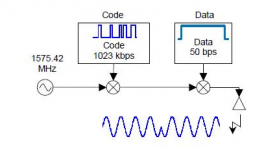Before explaining how these techniques could be used for on-board multistatic radar, a little more preparation is needed.
For this I will give explanations based on examples taken from navigation satellites. It is important to realise that from the point of view of detection, the performance of satellite navigation receivers is extraordinary. The satellites are 14,000 km away, the transmission power is a few watts, the receivers do not have big antennas, and yet it works.
The detection method is the one I have described, but for it to be effective, the signal must be coded with codes that are called "gold" because they give a strong auto correlation and a weak cross correlation. This is how the coding is done:
A pure frequency would not allow this correlation search principle. In addition to the coding, the signal can include data:
And this can be useful, as we shall see.
Why explain all this? First of all, it is necessary to understand that radars, transmissions, jammers and navigation satellites use electromagnetic techniques that can converge; and the military signal from navigation satellites has very interesting characteristics. First of all, we know how to reserve its use to allies: we know how to "encrypt" the signal so that it is unusable for those who do not have the key. You will understand that I will say no more. We also know how to protect it against jamming, spoofing, ... and all electronic warfare techniques. This is very important because it is an extremely weak signal.
Then the collaboration of several platforms to form an extended sensor comes up against a problem of precise time which is precisely at the heart of the resolution by the navigation system of the localisation problem. Indeed, if 4 satellites are needed to obtain coordinates, it is because the unknowns of the problem to be solved are the three spatial coordinates and the time coordinate. The users of a navigation system therefore have at their disposal a shared time base which has the quality and precision of an atomic clock.











